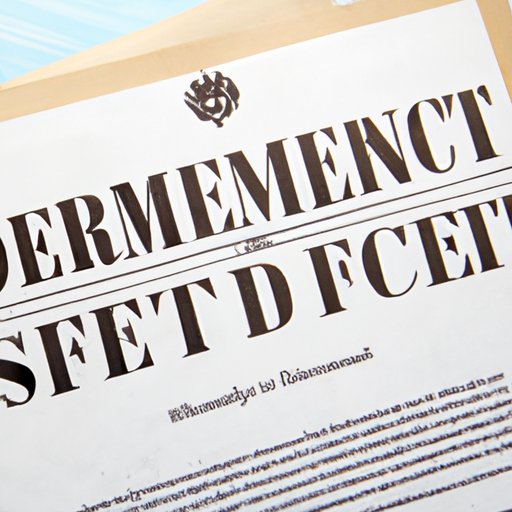Introduction
The military draft is a controversial yet necessary tool used by governments around the world to fill their armed forces with personnel. The draft has been used in various forms throughout history, but in the United States, it was last implemented during the Vietnam War in 1973. In this article, we will explore how the military draft works, what the implications are for those who may be drafted, and how to prepare for such a possibility.
Explaining the Military Draft Process: A Step-by-Step Guide
The military draft process in the United States is overseen by the Selective Service System (SSS). This independent agency of the federal government is responsible for registering all males aged 18-25 for potential conscription into the armed forces. Registration is required by law, and failure to register can lead to criminal penalties.
Registration is simple and can be done online or by mail. Once registered, the SSS maintains records of each individual’s name, address, date of birth, and Social Security Number. This information is then used by the Department of Defense to identify potential recruits should the need arise.
If called upon to serve, individuals must present themselves at a recruiting station within 30 days of notification. They will then be given a physical examination and aptitude test to determine their suitability for military service.
Understanding the Military Draft System: How Does It Work?
The draft selection process is based on a lottery system. Each year, a series of numbers is drawn from a pool of registered individuals, and those chosen are eligible for military service. The order in which numbers are chosen is random, meaning that there is no way to predict or influence who will be selected.
In general, any male between the ages of 18 and 25 can be drafted. However, certain categories of people are exempt from the draft, including those with physical or mental disabilities, conscientious objectors, and individuals with strong religious convictions.
Once an individual has been chosen, they will be contacted by the SSS and given instructions on how to proceed. They may be asked to report to a local recruiting office, where they will receive further instructions. If they refuse to comply, they may face criminal charges.

The Military Draft: All You Need to Know
Under United States law, the military draft is legal and binding. Those who are drafted are legally obligated to serve in the armed forces, regardless of their personal feelings on the matter. Refusal to comply can result in criminal penalties, including fines and imprisonment.
However, certain individuals are exempt from the draft. These include pregnant women, those with dependent children, full-time college students, and members of the clergy. Additionally, individuals can apply for deferment if they meet certain criteria, such as being the sole caregiver for a family member.
Those who are drafted also have certain rights under the law. For example, they can request a review of their case before a draft board, and they can appeal any decisions made by the board. They also have the right to seek legal counsel if they feel their rights have been violated.
What Is the Military Draft and How Does It Affect You?
Being drafted into the military can have far-reaching implications for one’s life. For starters, those who are drafted must put their lives on hold for an extended period of time. Depending on the length of their service, they may miss out on opportunities for career advancement, education, and other life experiences.
Additionally, those who are drafted may experience psychological distress due to the sudden change in their circumstances. According to a study conducted by the National Center for PTSD, “draftees reported significantly more post-traumatic stress disorder symptoms than non-draftees” (Maguen et al., 2009).
How the Military Draft Impacts Your Life: An Overview
While the prospect of being drafted can be daunting, there are certain steps you can take to prepare yourself. First and foremost, it’s important to understand your rights and the legalities of the draft. Knowing what to expect can help alleviate some of the anxiety associated with the process.
It’s also important to consider the potential psychological impacts of being drafted. Those who are drafted may experience feelings of fear, anger, and helplessness. Taking steps to manage these emotions, such as talking to a therapist or joining a support group, can help mitigate the negative effects of the draft.
Conclusion
The military draft is a complex and often controversial process. Understanding how the draft works and knowing your rights can help to ease any anxieties you may have about the prospect of being drafted. Additionally, taking steps to prepare yourself emotionally can help to minimize the potential psychological impacts of the draft.
(Note: Is this article not meeting your expectations? Do you have knowledge or insights to share? Unlock new opportunities and expand your reach by joining our authors team. Click Registration to join us and share your expertise with our readers.)
